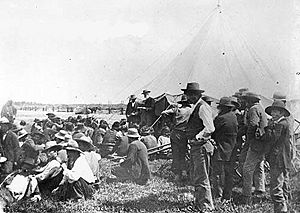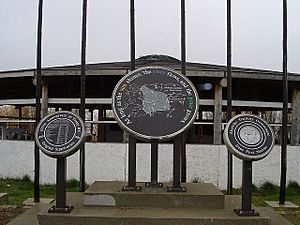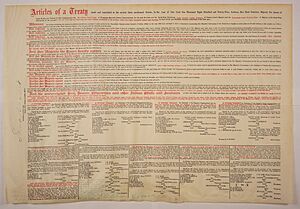Treaty 8 facts for kids

David Laird explaining terms of Treaty 8, Fort Vermilion, 1899
|
|
| Signed | June 21, 1899 |
|---|---|
| Location | Just south of present-day Grouard, Alberta |
| Parties |
|
| Languages | English |

Treaty 8 is a very important agreement signed on June 21, 1899. It was made between representatives of the Canadian government (called "the Crown") and several First Nations groups from the Lesser Slave Lake area. This treaty is one of eleven "Numbered Treaties" and covers a huge area of land.
The land included in Treaty 8 is about 840,000 square kilometers. This makes it the largest of all the Numbered Treaties by size. It includes thirty-nine First Nation communities. These communities are located in northern Alberta, northwestern Saskatchewan, northeastern British Columbia, and the southwest part of the Northwest Territories. The treaty was first agreed upon near what is now Grouard, Alberta.
Before Treaty 8, the Canadian government had signed Treaties 1 to 7 between 1871 and 1877. These earlier treaties covered the southern parts of what was then the North-West Territories. At that time, the government didn't think a treaty was needed for the northern areas. They believed the conditions there were not good for new settlements. Treaty 8 was one of the last treaties signed with First Nations in British Columbia for a long time.
There is a bit of confusion about the exact border between Treaty 8 and Treaty 11. For example, the Yellowknives Dene First Nation signed Treaty 8. However, their traditional land, known as Chief Drygeese Territory, is described in the text of Treaty 11.
Contents
What is Treaty 8 About?
Treaty 8 was signed for "peace and friendship" and was seen as a partnership. It is the most detailed of all the Numbered Treaties. The land it covers is huge, about 324,900 square miles. This area stretches across northern parts of British Columbia, Alberta, Saskatchewan, and the Northwest Territories.
Today, thirty-nine First Nations communities are part of Treaty 8. The leader of the First Nations of Treaty 8 in Alberta is Grand Chief Arthur Noskey. He was re-elected on July 30, 2021.
Why Was Treaty 8 Needed?
In the late 1890s, many people were heading north. They were inspired by the Klondike Gold Rush, a time when many went to search for gold. These prospectors (gold seekers) and settlers started moving into lands that were not yet part of any treaty. These lands were north of Treaty 6.
Because of this movement, the Canadian government decided to extend the treaty process further north. This new treaty area included places like Lake Athabasca, Great Slave Lake, and parts of the Peace River region. Around this time, scientists had also found out that there was oil in the Athabaska region. This made the land even more important to the government.
Who Signed Treaty 8?
The land covered by Treaty 8 is about 840,000 square kilometers. This is bigger than the country of France! It includes northern Alberta, northeastern British Columbia, northwestern Saskatchewan, and the southernmost part of the Northwest Territories.
After the main signing in June 1899, more agreements, called "adhesions," were signed. These happened in many different places in 1899 and 1900. Some of these places included Peace River Landing, Fort Vermilion, Fort Chipewyan, Fort McMurray, and Fort St. John.
Many people signed Treaty 8. Important First Nations leaders included Chief Keenooshayoo, Headman Moostoos, Headman Felix Giroux, Headman Wee Chee Way Sis, and Headman Charles Neesotasis. The First Nations groups that signed included the Woodland Cree, Dane-zaa (also called Beaver), and Chipewyan.
Government representatives and other important people also signed. These included David Laird, James Hamilton Ross, and Matthew McCauley.
The Role of Albert Lacombe
Before the treaty negotiations began, government officials asked for help from missionaries. These were people from the Oblate (OMI) religious group who had lived among the First Nations for many years. They had seen how the lives of First Nations people had changed a lot since the 1870s. The missionaries believed the treaties were the "lesser of two evils," meaning they thought it was the best option in a difficult situation.
The government chose a Catholic missionary named Albert Lacombe to be a consultant and mediator for Treaty 8. He was trusted by the First Nations because of his long experience with them. His job was to help convince First Nations that signing the treaty was a good idea for them.
Albert Lacombe was present on June 21, 1899, when the main treaty was signed. He told the First Nations that their way of life would mostly stay the same. He was also at some of the meetings where the "adhesions" were signed later on.
Treaty 8 included important promises to help the First Nations people keep their way of life. These promises included:
- Rights to land.
- Ongoing financial support.
- Yearly shipments of hunting supplies.
- Hunting rights on the lands they shared, unless those lands were used for things like logging, mining, or new settlements.
See also


